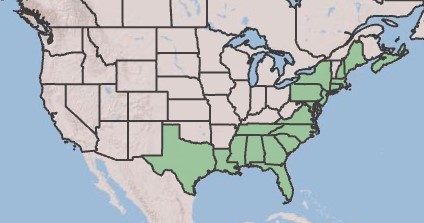Difference between revisions of "Clethra alnifolia"
(→Habitat) |
|||
| (3 intermediate revisions by 2 users not shown) | |||
| Line 17: | Line 17: | ||
| range_map_caption = Natural range of ''Clethra alnifolia'' from USDA NRCS [https://plants.sc.egov.usda.gov/home/plantProfile?symbol=CLAL3 Plants Database]. | | range_map_caption = Natural range of ''Clethra alnifolia'' from USDA NRCS [https://plants.sc.egov.usda.gov/home/plantProfile?symbol=CLAL3 Plants Database]. | ||
}} | }} | ||
| − | Common name: coastal | + | Common name: coastal sweet-pepperbush, coastal white-alder |
==Taxonomic Notes== | ==Taxonomic Notes== | ||
| − | Synonyms: | + | Synonyms: none<ref name=weakley>Weakley, A.S. 2020. Flora of the Southeastern United States. Edition of 20 October 2020. University of North Carolina at Chapel Hill, Chapel Hill, North Carolina.</ref> |
| + | |||
| + | Varieties: none<ref name=weakley/> | ||
==Description== | ==Description== | ||
<!-- Basic life history facts such as annual/perennial, monoecious/dioecious, root morphology, seed type, etc. --> | <!-- Basic life history facts such as annual/perennial, monoecious/dioecious, root morphology, seed type, etc. --> | ||
| Line 25: | Line 27: | ||
==Distribution== | ==Distribution== | ||
==Ecology== | ==Ecology== | ||
| − | + | ===Habitat=== | |
| + | ''C. alnifolia'' has been found in open areas of longleaf pine flatwoods and peat swamps. The plant can be thicket forming, and grows in moist, sandy loam to loamy sand soils. ''C. alnifolia'' will also perform well in disturbed areas such as along roadsides.<ref name = fsu> Florida State University Robert K. Godfrey Herbarium database. URL: http://herbarium.bio.fsu.edu. Last accessed: May 2023. Collectors: Loran C. Anderson, Kathleen Craddock Burks, Robert K. Godfrey, R. Komarek, Karen MacClendon, and Travis MacClendon. States and counties: Florida: Calhoun, Lafayette, Liberty, and Wakulla.</ref> | ||
| + | |||
| + | Associated Species of ''C. alnifolia'' include ''[[Pinus serotina]]'' and ''[[Cyrilla racemiflora]]''.<ref name=fsu/> | ||
<!--===Phenology===--> <!--Timing off flowering, fruiting, seed dispersal, and environmental triggers. Cite PanFlora website if appropriate: http://www.gilnelson.com/PanFlora/ --> | <!--===Phenology===--> <!--Timing off flowering, fruiting, seed dispersal, and environmental triggers. Cite PanFlora website if appropriate: http://www.gilnelson.com/PanFlora/ --> | ||
<!--===Seed dispersal===--> | <!--===Seed dispersal===--> | ||
Latest revision as of 10:00, 26 May 2023
| Clethra alnifolia | |
|---|---|
| Scientific classification | |
| Kingdom: | Plantae |
| Division: | Magnoliophyta - Flowering plants |
| Class: | Magnoliopsida - Dicots |
| Order: | Ericales |
| Family: | Clethraceae |
| Genus: | Clethra |
| Species: | C. alnifolia |
| Binomial name | |
| Clethra alnifolia L. | |

| |
| Natural range of Clethra alnifolia from USDA NRCS Plants Database. | |
Common name: coastal sweet-pepperbush, coastal white-alder
Contents
Taxonomic Notes
Synonyms: none[1]
Varieties: none[1]
Description
Distribution
Ecology
Habitat
C. alnifolia has been found in open areas of longleaf pine flatwoods and peat swamps. The plant can be thicket forming, and grows in moist, sandy loam to loamy sand soils. C. alnifolia will also perform well in disturbed areas such as along roadsides.[2]
Associated Species of C. alnifolia include Pinus serotina and Cyrilla racemiflora.[2]
Conservation, cultivation, and restoration
Cultural use
Photo Gallery
References and notes
- ↑ 1.0 1.1 Weakley, A.S. 2020. Flora of the Southeastern United States. Edition of 20 October 2020. University of North Carolina at Chapel Hill, Chapel Hill, North Carolina.
- ↑ 2.0 2.1 Florida State University Robert K. Godfrey Herbarium database. URL: http://herbarium.bio.fsu.edu. Last accessed: May 2023. Collectors: Loran C. Anderson, Kathleen Craddock Burks, Robert K. Godfrey, R. Komarek, Karen MacClendon, and Travis MacClendon. States and counties: Florida: Calhoun, Lafayette, Liberty, and Wakulla.